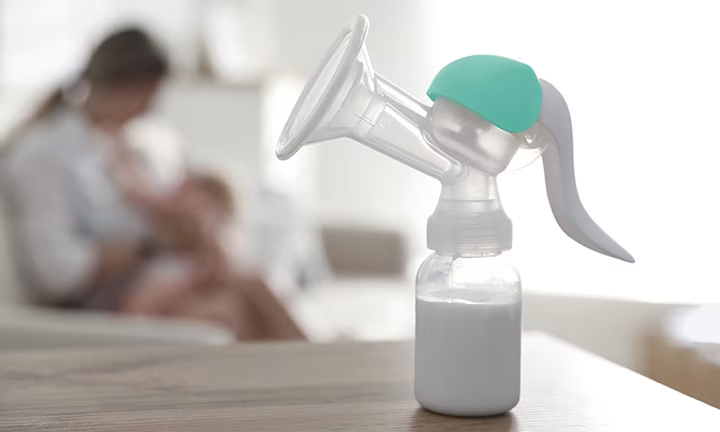
The 8 Best Breast Pumps
Key Takeaways
"Pampers may collect a share of sales or other compensation from the links on this page if you decide to shop through them."
Breast pumps can be an invaluable tool for nursing moms, but with lots of different types and features to wade through, it can be hard to know which one to buy. We surveyed more than 10,000 Pampers Parents to get the low-down on the best manual, electric, and battery operated breast pumps, and collated lots of insights and information on how to choose and use a breast pump. Discover everything you need to know about breast pumps right here.
What Is a Breast Pump?
Breast pumps are devices that help you extract your breast milk so that you can store it for later or give it to your baby via a bottle. The basic parts of a breast pump are:
Why Use a Breast Pump?
Breast pumps are useful for many reasons and in many situations, including:
Types of Breast Pumps
There are two main types of breast pumps, powered pumps and manual pumps. What’s right for you may depend upon how often you plan to pump. Read on to learn more about each type.
Electric and Battery-Powered Pumps
Powered pumps, using either an electrical plug-in or batteries, have a motor that creates suction to express milk from your breast. These pumps have one or more long tubes that connect the breast shield to the pump mechanism. Powered pumps are ideal if you pump often, as they can work more quickly than manual pumps. Powered pumps have a control panel to adjust the level and speed of suction. Electric breast pumps and battery-powered pumps come in single or double versions. Single models express milk from only one breast at a time. Double pumps can extract milk from both breasts at once. Some electric breast pumps can convert to battery-powered pumps for easier portability when needed. If you go with an electric or battery-powered pump, you might also want to have a manual pump for backup in case you lose power or don’t have extra batteries on hand.
Manual Pumps
With manual pumps, you place the breast shield over your nipple, Then, often by squeezing some kind of handle or lever, you create suction to express milk from your breast into an attached container. Manual pumps are simple and small. They’re great if you need to pump only occasionally. However, it may take more time and effort to pump using a manual pump compared to an electric pump. Manual pumps are often single pumps, which means they extract milk from only one breast at a time.
What to Consider When Choosing a Breast Pump
Pampers Parents helped narrow down the huge selection of breast pumps on the market by voting for their favorites, but there are still some things to keep in mind when you’re choosing the best breast pump for you:
Tips for Using Your Breast Pump
Here are some tips to help get the best results when you use your breast pump:
Tips for Cleaning Your Breast Pump
Follow these guidelines for cleaning your breast pump:
Top 5 Electric and Battery-Operated Breast Pumps
Many electric breast pumps can convert to battery power. Powered pumps are best if you need to pump often.
1. Spectra Baby USA—S2 Plus Electric Breast Pump
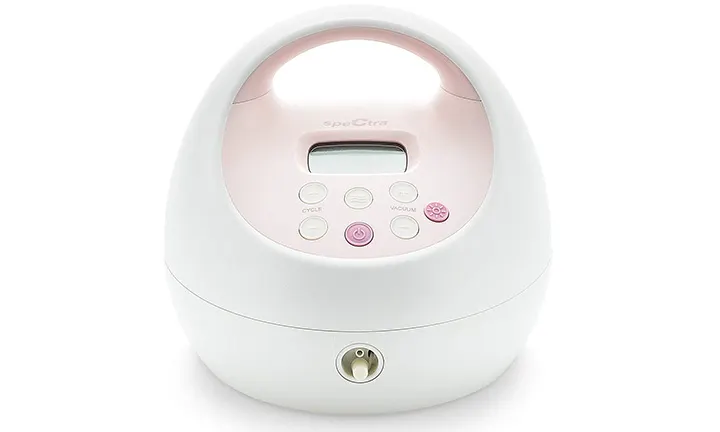
Why pick this one? This electric single or double breast pump system from Spectra Baby USA was chosen as the top electric breast pump by Pampers Parents. It’s quiet and offers an adjustable pumping rate to help suit the natural milk flow rate of your body. Spectra’s closed-system pump prevents milk from getting into the pump tubes and motor. This pump set includes two wide-neck bottles, two backflow protectors, two duckbill valves, two tubes, four flanges, and an AC adapter. Some Pampers Parents thought that this breast pump system was not ideal if you travel a lot or want to take it to and from work each day.
I like that it’s small, very practical to use, makes very little noise, and includes a light that makes it so practical when pumping at night.
Pampers Parent
Highlights: This breast pump has a built-in night-light that’s handy if you need to pump in the middle of the night.
Price*: about $159.00 on Amazon.com
Pampers Parents pros and cons:
2. Medela Pump in Style Advanced with On-the-Go Tote
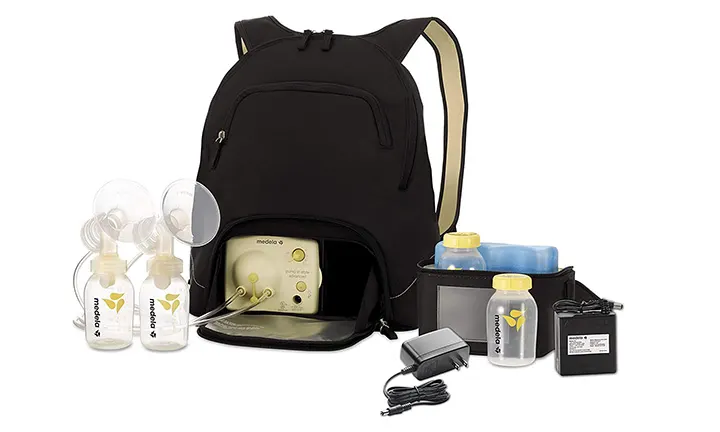
Why pick this one? This model’s complete electric double breast pump kit has everything you might need for easy breast pumping. This open-system, electric pump can convert to being battery-operated when you need it to. This pump is great if you need to pump several times a day because the electric power or battery power makes expressing easy and reasonably fast. The pump settings are customizable with a knob, plus there is one-touch easy vacuum release. Keep in mind that several Pampers Parents mentioned they’d like the motor to be a bit quieter. This set includes two breast shields to help you find a comfortable fit for your breast. It also includes a four-pack of five-ounce bottles with lids, an AC adapter, and a battery pack (batteries not included). You’ll also get a handy microfiber carry bag and a cooler pack to keep your pumped breast milk cool until you can refrigerate or freeze it.
I absolutely love this breast pump. I have used it with all three of my kids and it’s still going strong. All parts can easily be replaced without breaking the bank. It’s very reliable.
Pampers Parent
Highlights: With the purchase of this breast pump kit, among other helpful support options, Medela offers access to lactation consultants through its website and app.
Price*: about $285.00 on Amazon.com
Pampers Parents pros and cons:
3. Lansinoh Signature Pro Double Portable Electric Breast Pump
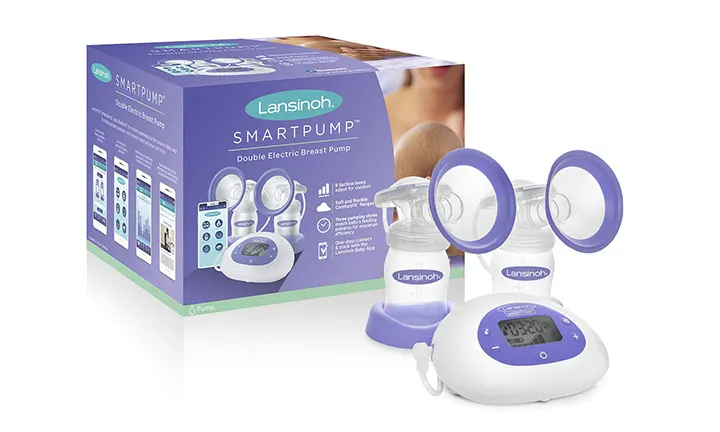
Why pick this one? This closed-system pump has eight suction levels as well as three pumping styles to suit your body’s natural flow level. It can be used as a single or a double breast pump. Along with the basic components, this set includes a two-pack of five-ounce bottles with caps, two flanges, three connection tubes, a Y-tubing connector, a tote bag, and an AC adapter. A few Pampers Parents mentioned that the print on the bottles can wear off easily.
It’s very easy to put together. I’ve been using it for five months now and it’s still working great!
Pampers Parent
Highlights: It offers the option to pump directly into pre-sterilized Lansinoh breast milk storage bags, which can be purchased separately.
Price*: about $82.49 on Amazon.com Pampers Parents pros and cons:
4. Elvie Double Electric Wearable Smart Breast Pump
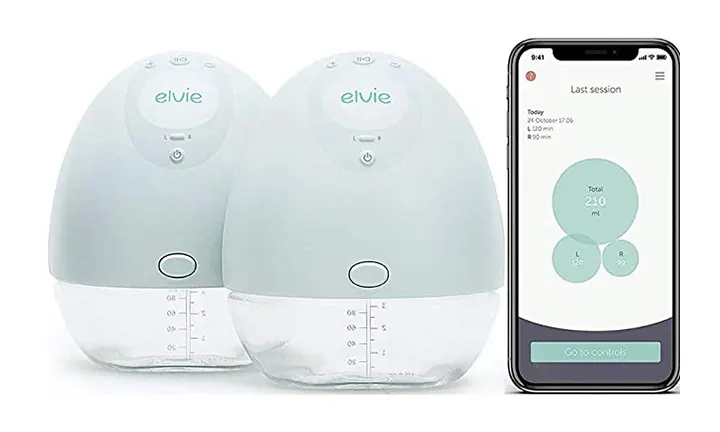
Why pick this one? If you’re looking for a wearable breast pump, look no further than the Elvie. It’s small, light, quiet, and can be used practically anywhere. Wear it at home, while at work, or during travel. You no longer have to be wired to a breast pump. You can use any standard nursing bra with the Elvie, so it’s completely hands-free. Setting it up and cleaning it is also very simple—there are only five parts that need cleaning. The pump can automatically switch from stimulation mode to expression mode when it senses letdown. It also pauses when the bottle is full.
I love how easy it is to use the Elvie. It’s portable, completely wireless, and powerful. Elvie has an app that allows me to control pumping more discreetly on my phone instead of having to lift up my shirt to change suction/speed.
Pampers Parent
Highlights: Connect to the free app to monitor your milk volume, track pumping history, and control the pump remotely without having to undo your bra.
Price*: about $497.95 on Amazon.com
Pampers Parents pros and cons:
5. Philips AVENT Double Electric Comfort Breast Pump
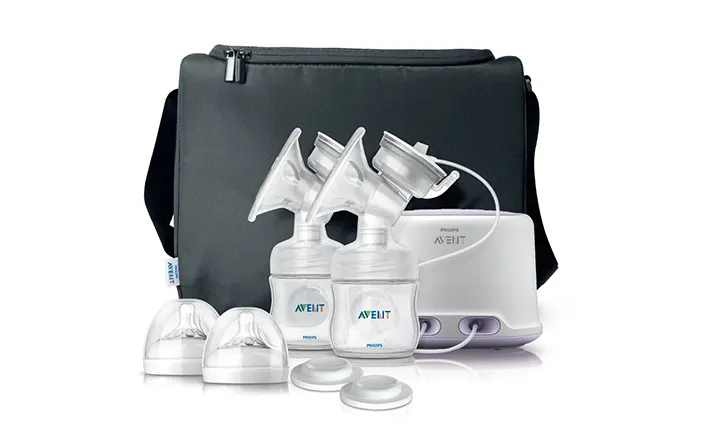
Why pick this one? This double breast pump set is a closed system, meaning that your breast milk never comes into contact with the suction tubing. The pump features a soft massaging cushion to help stimulate the flow of your breast milk. Once you complete the initial stimulation mode, this pump has three expression settings. This pump set includes a two-pack of four-ounce bottles, breast pad sample packs, and a travel bag. Some Pampers Parents mentioned that they thought this pump would be even better if it was a little quieter.
It’s so comfortable and I got more milk with the AVENT Double Electric Comfort Pump than using a Medela Pump!
Pampers Parent
Highlights: This Philips AVENT breast pump set includes two extra-soft silicone newborn-flow nipples so you can go easily from pumping your breast milk to bottle feeding.
Price*: about $206.20 on Amazon.com
Pampers Parents pros and cons:
Top 3 Manual Breast Pumps
Manual pumps are a must for when you’re on-the-go, and I personally felt I get the same, if not more, output than with the electric kind.
Pampers Parent
Manual pumps are ideal if you don’t need to pump very often, or if you would like to tote one around for “emergency” situations such as preventing engorgement. These are the manual breast pumps that Pampers Parents voted as their favorites:
1. Haakaa Silicone Breastfeeding Manual Breast Pump
Why pick this one? This 100 percent soft silicone breast pump expresses milk with manual suction. All you have to do is attach this pump to your nipple and begin gently squeezing the soft bottom portion of the pump. This breast pump comes in handy when you’re out and about and quickly need to relieve the engorgement. It can also be used to help prevent you from losing milk that’s let down (when your breast milk is ready to flow) in one breast when you’re feeding your baby on the other breast. Several Pampers Parents mentioned that the volume measurements on this pump aren’t accurate.
I love my Haakaa because I can use it while I’m breastfeeding… I use it during the first nursing session of the day and it helps with engorgement from overnight!
Pampers Parent
Highlights: Its small size makes it handy for travel. It’s also easy to clean since it doesn’t have multiple pieces and is dishwasher safe.
Price*: about $12.94 on Amazon.com
Pampers Parents pros and cons:
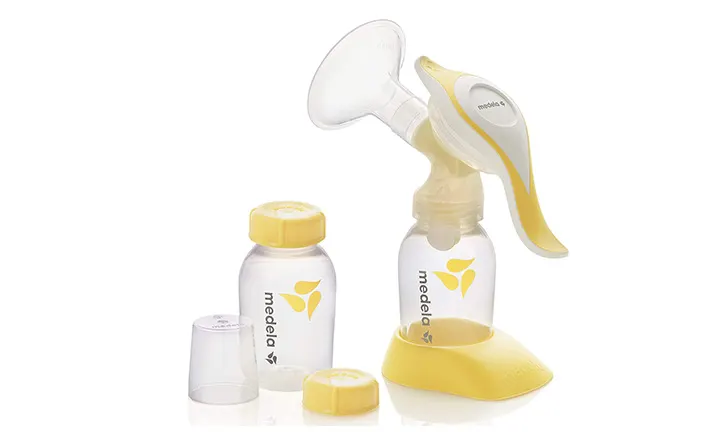
Why pick this one? This manual breast pump is great for occasional use. It has a soft-touch, ergonomic handle for your comfort. This pump comes with a two-pack of five-ounce bottles, a bottle stand, a nipple with a collar, a cap, and two filter membranes. A few Pampers Parents noted that the filter membranes tear somewhat easily and then need to be replaced.
It’s small and easy to put together. The two suction types on the handle lever mimic your baby’s sucking. It’s great that you can control the pressure and length of the pump action.
Pampers Parent
Highlights: This single breast pump features “2-Phase Expression Technology,” which is supposed to mimic the way a baby suckles. The first phase involves faster suction to get the milk flowing, and the second phase happens once the milk’s flowing and is a slower suction rate.
Price*: about $34.90 on Amazon.com
Pampers Parents pros and cons:
3. Philips AVENT Breast SCF330/30 Pump Manual
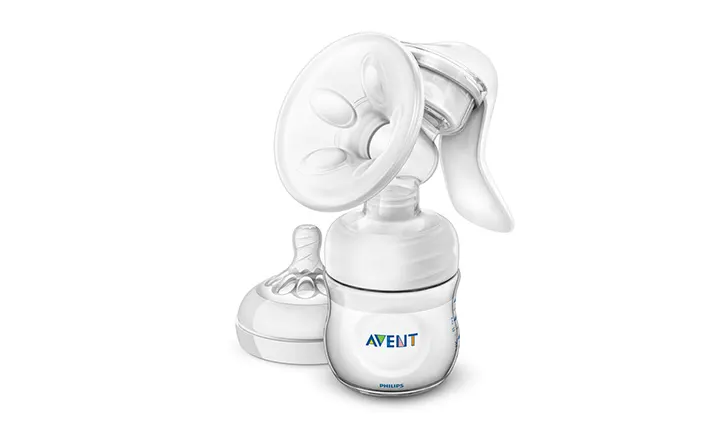
Why pick this one? This manual pump has a soft, textured cushion to help comfortably massage your breast to stimulate milk flow. This lightweight pump is easy to tote around when you’re on the go. This pump comes with a naturally shaped nipple to attach to the pump bottle for easy bottle feeding right after pumping.
It has simple parts, it fits me right, and it’s comfortable to use. I like that I can see and control how much milk comes out.
Pampers Parent
Highlights: Because of this pump’s angled neck, you can sit comfortably upright and your milk will still flow naturally from the breast to the bottle.
Price*: about $44.99 on Amazon.com
Pampers Parents pros and cons:
The Bottom Line
A breast pump is a nice convenience, and sometimes even a necessity if you plan to express and store your breast milk for later. Supplementing breastfeeding with bottle feeding breast milk also gives your partner and other family members the opportunity to share the beautiful experience of feeding your baby. We hope this Pampers Parents list of the top-voted breast pumps helps you choose one that works well for you!
Read more about Best Baby Products
Related Articles
Join a World of Support
through Pregnancy and Parenthood.
TRACK WITH TOOLS
LEARN WITH EXPERTS
GET REWARDED












